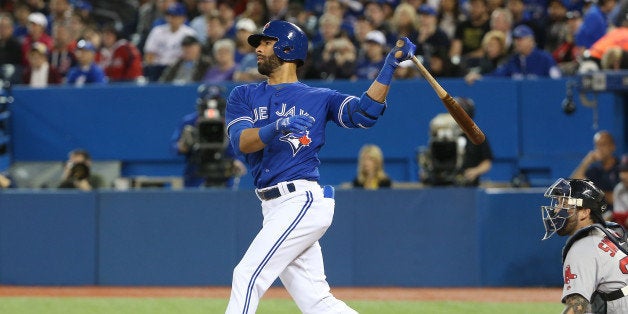
Welcome to this little crash course on hard hit rates, an advanced baseball statistic that will help you dominate your fantasy baseball leagues. Hopefully you caught my colleague Alex Roberts' article on how utilizing a player's Batting Average on Balls In Play (BABIP) can help you succeed. Here's another weapon for you.
Hard hit rate relates to several things: the velocity at which a baseball leaves the bat after contact is made, the hang time, and the angle at which it is hit all mixed together in an algorithm. We're going to keep it simple, though there is much contention over what exact point constitutes a hard hit ball. Just know that hard hit rates have been shown to correlate to greater batting performance.
Why Should You Trust Hard Hit Rates?
Hard hit rate is part of a trio of metrics (along with soft and medium rates) that add up to 100 percent to show the quality of contact being made by a batter. While it is possible for a well-struck ball to result in an out, the likelihood of a positive outcome for the batter is greatest when they hit the ball hard. A phrase that comes to mind here is "make your own luck".
Let's first get a reference point for the stat. The average hard hit rate in 2012 was 28.5 percent, in 2013 it was 30.5 percent, and in 2014 it was 29.1 percent, so it's safe to say that ~30 percent is a decent expected average.
Let's look at 2015's hard-hit leaders: J.D. Martinez (42.8 percent), David Ortiz (41.9 percent), Matt Kemp (41.6 percent), Paul Goldschmidt (41.4 percent), Chris Davis (41.4 percent), Bryce Harper (40.9 percent), Mike Trout (40.8 percent), and Miguel Cabrera (40.1 percent). It's worth noting that both Giancarlo Stanton (49.7 percent) and Miguel Sano (43.2 percent) would also be there, but didn't log enough at bats to qualify.
Obviously, these are high quality hitters. They featured prominently in our preseason RotoBaller consensus rankings.
How Can Hard Hit Rate Help Predict Future Performance?
We're now in the throes of baseball season. We have a constant trickle of data and statistics flowing to our brains. It feels as though one's whole season hangs in the balance as we decide whose hot start is real and which drafted player's cold streak means they're worth cutting. Last season Toronto Blue Jays slugger Jose Bautista had five homers through April, but they came with a meager .164 batting average. What is one supposed to do after a whole month of struggles?
The aforementioned BABIP stat is a nice starting point when looking "under the hood". Bautista's BABIP was a laughably low .132 through April (his career figure for that is .268). Remember those numbers showing the average hard hit rates and those of the best in the game? Well Bautista's April hard hit rate was a robust 37.2 percent, which explains why the homers were still there. It also points to how his average soon turned a corner. Bautista makes for a good case study to show how hard hit rates can help identify which players are due to bounce back and which have really fallen off.
The Rise of Exit Velocity
If you've watched a game recently then you may have heard the term "exit velocity" being thrown around, perhaps an announcer's offhand comment or through use of MLB's Statcast. Savvy fantasy players can now look at exactly how hard balls were hit to further determine the validity of a hot or cold streak.
This young season has seen many hot starts, but which should you believe in? One hint might be found in how many balls have been hit at 100-plus MPH by a player thus far (as of this being written on April 13). Three players lead the way so far with 13 such batted balls: Carlos Gonzalez, Mike Moustakas, and Carlos Correa. All three of them are also in the top 10 on the hard hit rate leaderboard so far.
Here's a great point, again this is through April 13, Carlos Gonzalez is batting .357, Carlos Correa is batting .355, but Mike Moustakas is only batting .214. If you have Moustakas and are put off by his average thus far, this tells you that he's actually seeing the ball well and making great contact. Neat, yes?
How to Best Utilize Hard Hit Rates to Win Your League
So now you're sitting there armed with knowledge, but what's the bottom line? You can now do the following with more confidence: analyze your own team and identify players who are "sell high" types, players who are on unsustainable hot streaks. You can also recognize those who are truly lost at the plate.
When hunting for potential pickups, you have a nice metric to use. Should you still be unsatisfied, then check RotoBaller's Waiver Wire pickups list. The fun isn't limited to your own team of course, as you now have another tool to find struggling players on other teams who make for sneaky targets in a trade.
As with any singular piece of information, never treat it as a "be all, end all" reference point. Hard hit rates in small windows of time can still represent outliers for players if you don't consider the context, even the best players. The question becomes where their "true production" level lies and how far they'll regress. Always investigate and never trust one lone stat.
In the end, if a player is hitting the ball hard, you should be paying attention. If poor surface statistics mask a strong batted ball profile, or vice versa, then there is a large profit margin to be capitalized upon. Now weaponize your newfound knowledge of hard hit rates to dominate your league.
